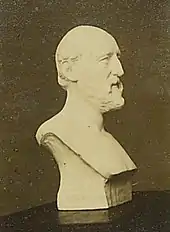Eugène Millon
Eugène Auguste Nicolas Millon (24 April 1812 – 22 October 1867) was a French chemist and physician. He is remembered in the name of Millon's reagent which reacts with tyrosine in proteins to form a brown precipitate. The reagent is used for determination of the presence of soluble proteins.

Millon was born in Saint-Seine-l'Abbaye and after his education, he taught briefly at the Collège Rollin after before training in medicine at the military hospital at Val-de-Grâce from 1832 to 1835. After serving for a while in the army he left surgery to study pharmacy and chemistry and became a pharmacist in 1838, serving from 1850 to 1865 in Algeria. His most well-known contribution was the reaction of mercury and nitric acid with egg albumen which produces a white precipitate that turns red on heating. His other contributions were on compounds of chlorine and iodine including the acids. He examined salts in blood.[1][2][3]
An Algerian stamp commemorating him was released in 1954.[4]
References
- Wisniak, J. (2020). "Auguste-Nicolas-Eugene Millon, Millon reagent, chlorine derivatives, and blood". Revista CENIC Ciencias Químicas. 51 (2): 337–352.
- Malangeau, Pierre (1968). "L'œuvre scientifique d'Eugène Millon". Revue d'Histoire de la Pharmacie Année (in French): 73–82.
- Anon (1870). E. Millon, sa vie, ses travaux de chimie et ses études économiques et agricole sur l'Algérie (in French). Paris: J.B. Bailliere et fils.
- Davidson, S. M. (1973). "Professional Standards Review Organizations". Journal of the American Medical Association. 226 (9): 1106–1108. doi:10.1001/jama.1973.03230090030006.